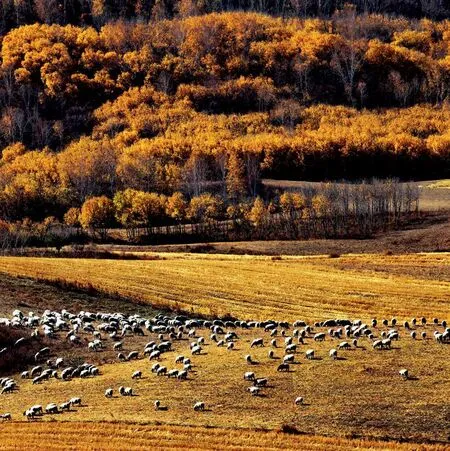MAGIC IN INNER MONGOLIA
PHOTOGRAPHS BY SU JINGZHONG (宿景忠) AND YANG LEI (杨雷) TEXT BY LIU JUE (刘珏)
MAGIC IN INNER MONGOLIA
PHOTOGRAPHS BY SU JINGZHONG (宿景忠) AND YANG LEI (杨雷) TEXT BY LIU JUE (刘珏)
The Heshigten Banner grasslands have an epic human history to match their stunning scenery
在充满地质奇迹的克什克腾旗,两个摄影师找到了他们心中的乐园
A few thousand kilometers from Beijing—where the air is fresher, the population thinner, and the land wide open—stands Keshenketeng Qi (克什克腾旗) or Heshigten Banner, in Chifeng City, Inner Mongolia, drawing thousands of tourists and photographers throughout the year with its scenic beauty and geological wonder. The Heshigten Global Geography Park, designated an area of outstanding natural beauty by UNESCO in 2005, offers a diverse range of landscapes. Grassland, desert, rock mountains, glacial remains, thermal springs, rivers, and lakes are all shaped by the mighty forces of nature and are simply breathtaking in the scope of their beauty. The park consists of eight areas, each with distinctive features, scattered throughout the vast land. “It’s a photographers’ Mecca,” says photo-journalist Yang Lei who teamed up with local photographer Su Jingzhong to capture the alluring charm of this northern land. Starting each day at 3 am, wrapped in down coats and with equipment safely packed in their trunk, Yang and Su drove through this mystic region, trying to capture those, oft elusive, perfect views throughout the day, only returning to their hotel rooms after nightfall to finally get some much needed rest. Their five-day photo trip focused on the valley of the Xar Moron River (西拉沐沦河 Xīlāmùlún Hé) and the magnificent and hilly UlanButong Grassland. (乌兰布统草原 Wūlánbùtǒng Cǎoyuán).

SHEEP HAVE LARGELY REPLACED GOATS AND HORSES ON THE INNER MONGOLIAN GRASSLANDS
Behind such amazing scenery is an equally magnificent human history. Six millennia ago, the Neolithic Hongshan Culture flourished here. Being one of the earliest cultures in the north, it also gave birth to the ancient and still much revered art of jade carving in China. Some 2,000 years later, it was the time for the brilliant bronze culture to boom. More recently, the area has served as an important location in military planning for the ancient Mongols. Genghis Khan selected over 500 local men from here to form his fierce private fighting troop, hence the name Heshigten (bodyguards’ squad) in Mongolian. Later, the grassland saw much bloodshed as great powers collided.
Nowadays, Heshigten Mongolians live here along with more than 10 other ethnic groups. Traditionally, the people rely on stockbreeding, farming, and mining for a living; although in the modern era, renewable energy, and tourism are on the rise to become the main industries.

SMOKE BILLOWS FROM THE JINING-TO-TONGLIAO STEAM TRAIN, HARKING BACK TO AN EARLIER ERA
THE STEAM TRAIN FESTIVAL
Between the end of December and early January, Heshigten Banner holds an annual Steam Train Festival on a mountainous section of the railway between Jining and Tongliao. Retired steam trains, once again, run slowly through tunnels, over bridges, sloping, and turning, providing the perfect backdrop for tourists and photographers from all over the world to marvel at this classic experience of days gone by.

THE SUN SETS BELOW THE HILLS OF THE XAR MORON RIVER

SUNLIGHT DAPPLES THROUGH THE TREES UNDER THE CLEAR BLUE SKY OF HESHIGTEN BANNER

ONCE A BATTLEFIELD, THE GRASSLANDS ARE NOW TRAMPLED BY TOURISTS, NOT WARRIORS

FOR NOW, THERE ARE A HOST OF TREES ON THE PRAIRE, BUT DESERTIFICATION IS A CONSTANT FEAR
THE ANCIENT BATTLE FIELD
In the south of Heshigten Banner, where the desert meets the Ulan Butong Grassland, lies an ancient battlefield. In 1690, the Kangxi (康熙) Emperor’s army engaged the rebellious Mongolian tribe, the Dzungar. The tribe constructed a camel wall, chaining 10,000 camels together as defense against the emperor’s artillery bombardment. Inevitably failing, the Dzungar chief Galdan Boshugtu Khan fled, and upon several repeated defeats took his own life seven years later.

PARTS OF THE GRASSLAND WERE DESIGNATED AN AREA OF OUTSTANDING NATURAL BEAUTY BY UNESCO IN 2005; IT'S EASY TO SEE WHY
HESHIGTEN MONGOLIANS
The Heshigten Mongolians were once one of the oldest nomadic tribes. Today, most of them have settled down in pastures set in a limited area and no longer travel. The numbers of goats and horses have also been cut back to protect the grassland from desertification, with sheep and cattle becoming the main livestock instead. Of the 250,000 population in Keshigten Banner, now only 30,000 are ethnic Mongolians. Despite the dramatic changes in the local lifestyle, people still come in hope of discovering authentic Mongolian culture.

